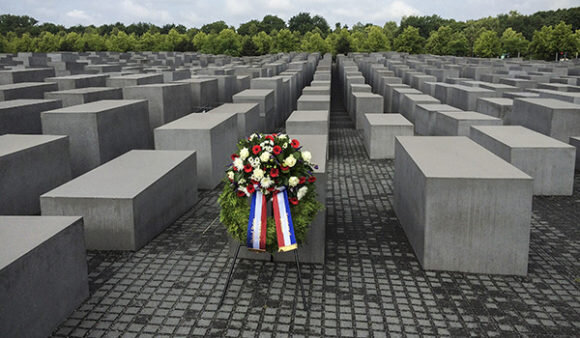We began our research with an online survey, sent via email to a combination of educators who have experienced the Museum’s current professional development opportunities, educators who have inquired about the Museum’s professional development, and a broad list of US-based secondary school teachers not known to be connected to the Museum. 366 responses to the survey were received.
In brief, analysis of the survey results shows that teachers identified the following needs as most pressing, in order from most frequently mentioned to least frequently mentioned:
1) resources to teach contemporary genocide and atrocity prevention
2) resources that save time
3) resources that are flexible
4) resources that alleviate isolation and financial constraints
5) resources to combat resistance to teaching these topics
Respondents to the survey who indicated that they would be willing to be interviewed to help the Museum delve deeper into survey findings were selected for telephone interviews. Respondents were chosen to represent a range of demographics: geography, race, ethnicity, subject matter taught, length of time teaching, whether or not they were recipients of the Museum’s professional development. The interviews reinforced the survey findings and allowed us to delve more deeply into key themes.
First, we will discuss the issues presented by those who are currently teaching the Holocaust and contemporary genocide; then we will turn to the themes presented by those who are not currently teaching these topics.
Educators currently teaching the Holocaust and contemporary genocide
Themes that emerged from these interviews focused on why teaching these subjects matter to them. We learned that teachers hope to make historical events real for their students and to help students relate to survivors. Many educators’ goals can be framed within the larger category of creating empathy; by doing so, they are able to help their students make connections, both to history and to those who have survived genocide. Even within our small interview sample, however, teachers grappled with both the positive and negative consequences of trying to create empathy.
Pros and Cons of Creating Empathy
Some educators explained that they want students to believe they can do something to stop these events, that they have power, and that they should try to make a difference. Others explained that they hoped their students would become kinder, more empathetic individuals as a result of studying these events. However, one respondent, a social studies teacher from a public school in Tennessee, voiced concern that a focus on emotion and feeling can be overwhelming: “… we’re trying to have students feel too much…empathy. They can come away with the impression that the world is bad, people are terrible”.
By contrast, another educator who teaches world history in a public school in South Carolina, said he hoped to make students uncomfortable by pointing to the complexities involved in studying historical events, that he hoped they would “come away from this with having more questions than answers.”
Numerous teachers mentioned that they want their students to be able to recognize warning signs in order to help prevent future genocide. A global studies public school teacher based outside of Seattle, Washington, hoped to contextualize current events both around the world and in the U.S. for his students:
We should be progressing as a society and in fact it’s just getting worse. Numbers, statistics, surveys – how little people know about the Holocaust. It feels as though the same attitudes are pervasive again. History repeating itself – I worry that it’s a realistic possibility. Modern atrocities happen. Could it happen in a modern country? Things happen in developing nations; I don’t actually know that it’s going to be exclusive to those….
Another educator– an English Language Arts teacher from Washington, D.C. who has taught in both private and public schools — qualified this notion:
We shouldn’t burden our students with this huge responsibility – [it’s] not just on them and that’s not fair. I want my students to feel that they have agency, their voice matters, absolutely, but I tend to do that more at a local level. True change can happen right in front of you.
Yet another example points to the fact that reactions to studying the Holocaust, or to meeting survivors, vary greatly based on the students’ life experiences. This educator works primarily with public high school students in rural Texas who are in the custody of Child Protective Services (provided to children who are at risk of or are experience physical, sexual or emotional abuse). In relating the experience of inviting a Holocaust survivor to talk with his students, he described a particularly poignant connection, and thereby message, his students received:
[The students] had been through some horrific stuff, abuse, mostly from family. I brought a Holocaust survivor in to speak to them…The way he connected with them – I mean, they heard all the horrible stuff, but it was like, to them, nobody understands the horrible stuff I’ve been through and I’m not going to ever be anything. And here’s someone who’s been through horrible stuff who’s done something with his life, ‘If he can do it, I can do it.’
Educators not currently teaching the Holocaust and contemporary genocide
Among those educators who do not teach about the Holocaust, contemporary genocide or atrocities with any depth or regularity, a few themes emerged: resistance from students, families, or administrators, or teachers themselves being concerned about “getting it wrong.” Teachers indicated that they feel isolated and without the support they need to manage these difficult subjects, especially because they do not have time or resources for professional development or even to bring their students to a museum.
Resistance
One educator, a social studies teacher from North Carolina, addressed the resistance to these subjects she encountered from her students:
Particularly in our area, people have come to accept hate. That sounds really harsh, but things that they see on TV, they don’t recognize the people who are being shot, or beaten. They don’t see them as people, almost as though they’ve been demonized already. [I can hear evidence of their] Families’ closemindedness, saying the press is fake, facts aren’t facts.
Lack of Time to Create New Units
An English Language Arts teacher from a public high school in Michigan described the barrier she faced due to diminishing support from schools for teacher professional development:
A unit that could take 12 hours to plan ends up taking 50 hours to plan, and when you have 5 classes to plan, that’s not ideal. There are schools that will give teachers PD time, or days, to create new units. But most of the schools around here won’t do that anymore. So there’s no curriculum time. That’s all on your own time. So if you’re creating from a documentary, or whatever, and you have to start from scratch and try to fill all the holes and tie into something else, it doesn’t always work. It’s not as cohesive.
Getting it wrong
Another teacher from a dense urban area of Texas gave voice to many of his colleagues’ fears of teaching difficult subjects:
As a US History teacher, I’m African American, and we talk about the last section of US history that we cover (Civil War, Reconstruction) there are SO many who don’t cover slavery, reconstruction, civil war with fidelity because “it makes me feel uncomfortable”. I can see this happening as well with the Holocaust…It doesn’t mean that you have all the answers, but you can’t gloss over the hard stuff.
* * *
In our Good Project research, conducted two decades ago, educators were among the “Caring” Professions we investigated. These were individuals who worked directly on behalf of others, including, for example, those involved in the medical professions. We learned that educators were especially vulnerable in terms of burnout. To summarize, without the support of peers or institutions, they often found it difficult to stay engaged. Although many found meaning in their work with students, maintaining their commitment to that work over time became increasingly difficult without a shared mission or sense of purpose.
Using this frame to understand our research involving contemporary educators, we can confirm that many of them feel vulnerable. Of all the survey respondents, 53 percent answered “yes” when asked if their students raise questions about recent or current instances of genocide or atrocities in the classroom. Overall findings from the survey and interviews showed that teachers want to be able to address these questions but either lack resources, awareness of resources, or resources they can realistically integrate into their classrooms based on constraints such as time and requirements.
As much as educators expressed a need for resources, they also expressed real fears about their own lack of knowledge. Many don’t feel ready to search for curricula or for extensive professional development: first, they’re seeking straightforward resources from a trusted source, even before beginning to tackle the creation of lesson plans. Teachers are looking for help with their own basic understanding because they are being asked tough questions by their students about the world today, whether educators teach instances of genocide or not.
While we didn’t survey students directly, we did survey educators about the kinds of student questions they found most challenging. Perhaps not surprisingly, educators reported that they found students’ existential questions about humanity’s capacity for genocide and atrocities difficult to answer. However, we were equally struck by the many teachers who reported that it was difficult for them to answer when students asked questions such as: “What is genocide?” or “Did the Holocaust really happen?” or “Why should I care?”
With the general population’s awareness of the Holocaust lower among millennials than older generations, we cannot simply assume that new teachers, most of whom are themselves millennials, will come to classroom teaching with knowledge of the Holocaust. Without access to broad, basic, introductory opportunities to make these connections themselves they cannot be expected to teach their students how to make meaningful connections to contemporary atrocities. It is our hope that this research will provide a useful foundation for the Center for the Prevention of Genocide to help both teachers and students turn the alienating question of “Why should I care?” into the shared mission of “I want – and need – to know more.”
Anne Burt is a consultant specializing in projects at the intersection of public engagement, communications, education, and the arts & humanities. From 2012-2018, she was Chief Communications Officer, then Chief Creative Officer, for the nonprofit organization Facing History and Ourselves. She teaches graduate courses in communications and marketing for Columbia University’s Nonprofit Management Program.
Lynn Barendsen is a Project Director at Project Zero, at the Harvard Graduate School of Education. Since 1996, she has been part of the Good Project, an effort to identify individuals and institutions that exemplify good work – work that is excellent in quality, socially responsible, and meaningful to its practitioners – and to determine how best to increase the incidence of good work in our society.










